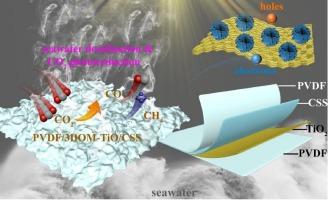Two-in-one integrated system—Solar energy activated interfacial collaborative conversions of photo-chemical and photothermal coupling reactions
IF 13.2
1区 工程技术
Q1 ENGINEERING, CHEMICAL
引用次数: 0
Abstract
Implementing solar energy-driven photochemical-photothermal coupling conversions represents an efficient strategy to overcome the limitations of single-function solar systems. In this paper, a two-in-one interfacial integrated system is constructed through in situ encapsulation of 3DOM-TiO2/Cu2SnS3 composite within a polyvinylidene fluoride (PVDF) membrane. The integrated system exhibits strong broadband sunlight absorption across the UV–Vis-NIR spectrum, enabled by the narrow band gap of Cu2SnS3 and the three-dimensional ordered macroporous (3DOM) structure of TiO2. This synergy delivers excellent photothermal conversion performance, accelerating interfacial water evaporation to achieve seawater desalination at the liquid-solid interface. Simultaneously, the 3DOM-TiO2/Cu2SnS3 heterostructure facilitates efficient separation of photogenerated charge carriers. The holes oxidize interfacial water vapor to release protons, while the electrons reduce CO2 with protons to CO, thereby enabling photocatalytic CO2 reduction at the gas-solid interface. Synergistically, this photochemical-photothermal coupling achieves a CO yield of 6.84 μmol‧g−1‧h−1 from CO2 reduction and an evaporation rate of 0.93 kg‧m−2‧h−1 in seawater desalination. Furthermore, the PVDF-supported system demonstrates long-term stability and recyclability, producing no secondary pollution and reducing the reaction cost. This work offers significant potential for co-producing solar fuels and freshwater.

二合一集成系统-太阳能激活光化学和光热耦合反应的界面协同转换
实现太阳能驱动的光化学-光热耦合转换是克服单一功能太阳能系统局限性的有效策略。本文通过在聚偏氟乙烯(PVDF)膜内原位封装3DOM-TiO2/Cu2SnS3复合材料,构建了二合一界面集成体系。由于Cu2SnS3的窄带隙和TiO2的三维有序大孔(3DOM)结构,该系统在紫外-可见-近红外光谱上具有较强的宽带吸收能力。这种协同作用提供了优异的光热转换性能,加速了界面水的蒸发,实现了液固界面的海水淡化。同时,3DOM-TiO2/Cu2SnS3异质结构有利于光生载流子的高效分离。空穴氧化界面水蒸气释放质子,电子带质子将CO2还原为CO,从而实现气固界面光催化CO2还原。在海水淡化过程中,这种光化学-光热耦合的协同作用使CO2还原的CO产率为6.84 μmol·g−1·h−1,蒸发速率为0.93 kg·m−2·h−1。此外,pvdf支持的体系具有长期稳定性和可回收性,不产生二次污染,降低了反应成本。这项工作为联合生产太阳能燃料和淡水提供了巨大的潜力。
本文章由计算机程序翻译,如有差异,请以英文原文为准。
求助全文
约1分钟内获得全文
求助全文
来源期刊

Chemical Engineering Journal
工程技术-工程:化工
CiteScore
21.70
自引率
9.30%
发文量
6781
审稿时长
2.4 months
期刊介绍:
The Chemical Engineering Journal is an international research journal that invites contributions of original and novel fundamental research. It aims to provide an international platform for presenting original fundamental research, interpretative reviews, and discussions on new developments in chemical engineering. The journal welcomes papers that describe novel theory and its practical application, as well as those that demonstrate the transfer of techniques from other disciplines. It also welcomes reports on carefully conducted experimental work that is soundly interpreted. The main focus of the journal is on original and rigorous research results that have broad significance. The Catalysis section within the Chemical Engineering Journal focuses specifically on Experimental and Theoretical studies in the fields of heterogeneous catalysis, molecular catalysis, and biocatalysis. These studies have industrial impact on various sectors such as chemicals, energy, materials, foods, healthcare, and environmental protection.
 求助内容:
求助内容: 应助结果提醒方式:
应助结果提醒方式:


